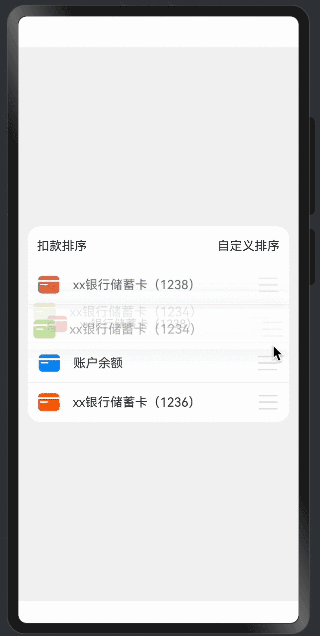173.HarmonyOS NEXT系列教程之列表交换组件数据模型设计
2025-03-23 22:44:23
256次阅读
0个评论
温馨提示:本篇博客的详细代码已发布到 git : https://gitcode.com/nutpi/HarmonyosNext 可以下载运行哦!

HarmonyOS NEXT系列教程之列表交换组件数据模型设计
效果演示

1. 数据模型基础
1.1 基础结构
@Observed
export class ListInfo {
// 列表项图标
icon: ResourceStr = '';
// 列表项名称
name: ResourceStr = '';
constructor(icon: ResourceStr = '', name: ResourceStr = '') {
this.icon = icon;
this.name = name;
}
}
1.2 响应式设计
// 使用@Observed装饰器实现响应式
@Observed
export class ListInfo {
// 当属性变化时,自动触发UI更新
}
2. 属性定义
2.1 资源类型
// 使用ResourceStr类型表示资源字符串
icon: ResourceStr = ''; // 图标资源
name: ResourceStr = ''; // 名称资源
// 资源使用示例
const item = new ListInfo(
$r("app.media.icon_example"), // 图标资源
$r("app.string.name_example") // 文本资源
);
2.2 默认值处理
constructor(
icon: ResourceStr = '', // 默认空字符串
name: ResourceStr = '' // 默认空字符串
) {
this.icon = icon;
this.name = name;
}
3. 响应式机制
3.1 数据监听
@Observed
export class ListInfo {
// 属性变化时自动触发更新
private updateIcon(newIcon: ResourceStr) {
this.icon = newIcon;
// 自动触发UI更新
}
private updateName(newName: ResourceStr) {
this.name = newName;
// 自动触发UI更新
}
}
3.2 使用场景
// 创建列表项
const item = new ListInfo($r("app.media.icon1"), $r("app.string.name1"));
// 更新属性会自动触发UI更新
item.icon = $r("app.media.icon2");
item.name = $r("app.string.name2");
4. 数据验证
4.1 类型检查
class ListInfoValidator {
static validateIcon(icon: ResourceStr): boolean {
return typeof icon === 'string' || icon instanceof Resource;
}
static validateName(name: ResourceStr): boolean {
return typeof name === 'string' || name instanceof Resource;
}
}
4.2 数据验证
class ListInfo {
private validateData() {
if (!ListInfoValidator.validateIcon(this.icon)) {
throw new Error('Invalid icon resource');
}
if (!ListInfoValidator.validateName(this.name)) {
throw new Error('Invalid name resource');
}
}
}
5. 工具方法
5.1 数据转换
class ListInfoConverter {
// 转换为显示格式
static toDisplayString(info: ListInfo): string {
return `${info.name} (${info.icon ? 'Has Icon' : 'No Icon'})`;
}
// 转换为存储格式
static toStorageFormat(info: ListInfo): string {
return JSON.stringify({
icon: info.icon,
name: info.name
});
}
}
5.2 数据克隆
class ListInfo {
clone(): ListInfo {
return new ListInfo(this.icon, this.name);
}
static fromObject(obj: any): ListInfo {
return new ListInfo(obj.icon, obj.name);
}
}
6. 性能优化
6.1 数据缓存
class ListInfoCache {
private static cache: Map<string, ListInfo> = new Map();
static get(key: string): ListInfo | undefined {
return this.cache.get(key);
}
static set(key: string, info: ListInfo): void {
this.cache.set(key, info);
}
static clear(): void {
this.cache.clear();
}
}
6.2 批量操作
class ListInfoBatchProcessor {
static updateBatch(items: ListInfo[], updates: Partial<ListInfo>): void {
items.forEach(item => {
Object.assign(item, updates);
});
}
}
7. 最佳实践
7.1 数据管理
- 使用响应式数据
- 实现数据验证
- 提供工具方法
- 优化性能表现
7.2 使用建议
- 合理设置默认值
- 验证数据有效性
- 实现数据转换
- 优化数据操作
8. 使用示例
8.1 基础用法
// 创建列表项
const item = new ListInfo(
$r("app.media.icon_example"),
$r("app.string.name_example")
);
// 更新属性
item.name = $r("app.string.new_name");
8.2 批量处理
// 创建多个列表项
const items = [
new ListInfo($r("app.media.icon1"), $r("app.string.name1")),
new ListInfo($r("app.media.icon2"), $r("app.string.name2"))
];
// 批量更新
ListInfoBatchProcessor.updateBatch(items, {
icon: $r("app.media.new_icon")
});
9. 小结
本篇教程详细介绍了:
- 数据模型的基础设计
- 响应式机制的实现
- 数据验证的方法
- 工具方法的开发
- 性能优化的策略
下一篇将介绍手势交互系统的实现。
00
- 0回答
- 5粉丝
- 0关注
相关话题
- 182.HarmonyOS NEXT系列教程之列表交换组件数据管理详解
- 165.HarmonyOS NEXT系列教程之列表交换组件Mock数据设计
- 163.HarmonyOS NEXT系列教程之列表交换组件数据管理机制
- 159.HarmonyOS NEXT系列教程之列表交换组件架构设计
- 179.HarmonyOS NEXT系列教程之列表交换组件工具类设计
- 183.HarmonyOS NEXT系列教程之列表交换组件布局设计详解
- 169.HarmonyOS NEXT系列教程之列表交换组件开发总结
- 161.HarmonyOS NEXT系列教程之列表交换组件列表项交互实现
- 176.HarmonyOS NEXT系列教程之列表交换组件列表项操作实现
- 162.HarmonyOS NEXT系列教程之列表交换组件删除功能实现
- 166.HarmonyOS NEXT系列教程之列表交换组件性能优化实现
- 167.HarmonyOS NEXT系列教程之列表交换组件最佳实践总结
- 168.HarmonyOS NEXT系列教程之列表交换组件实战应用案例
- 170.HarmonyOS NEXT系列教程之列表交换组件基础架构解析
- 174.HarmonyOS NEXT系列教程之列表交换组件动画系统实现
